MERCEDES-BENZ METRIS 2020 MY20 Operator’s Manual
Manufacturer: MERCEDES-BENZ, Model Year: 2020, Model line: METRIS, Model: MERCEDES-BENZ METRIS 2020Pages: 320, PDF Size: 26.38 MB
Page 291 of 320
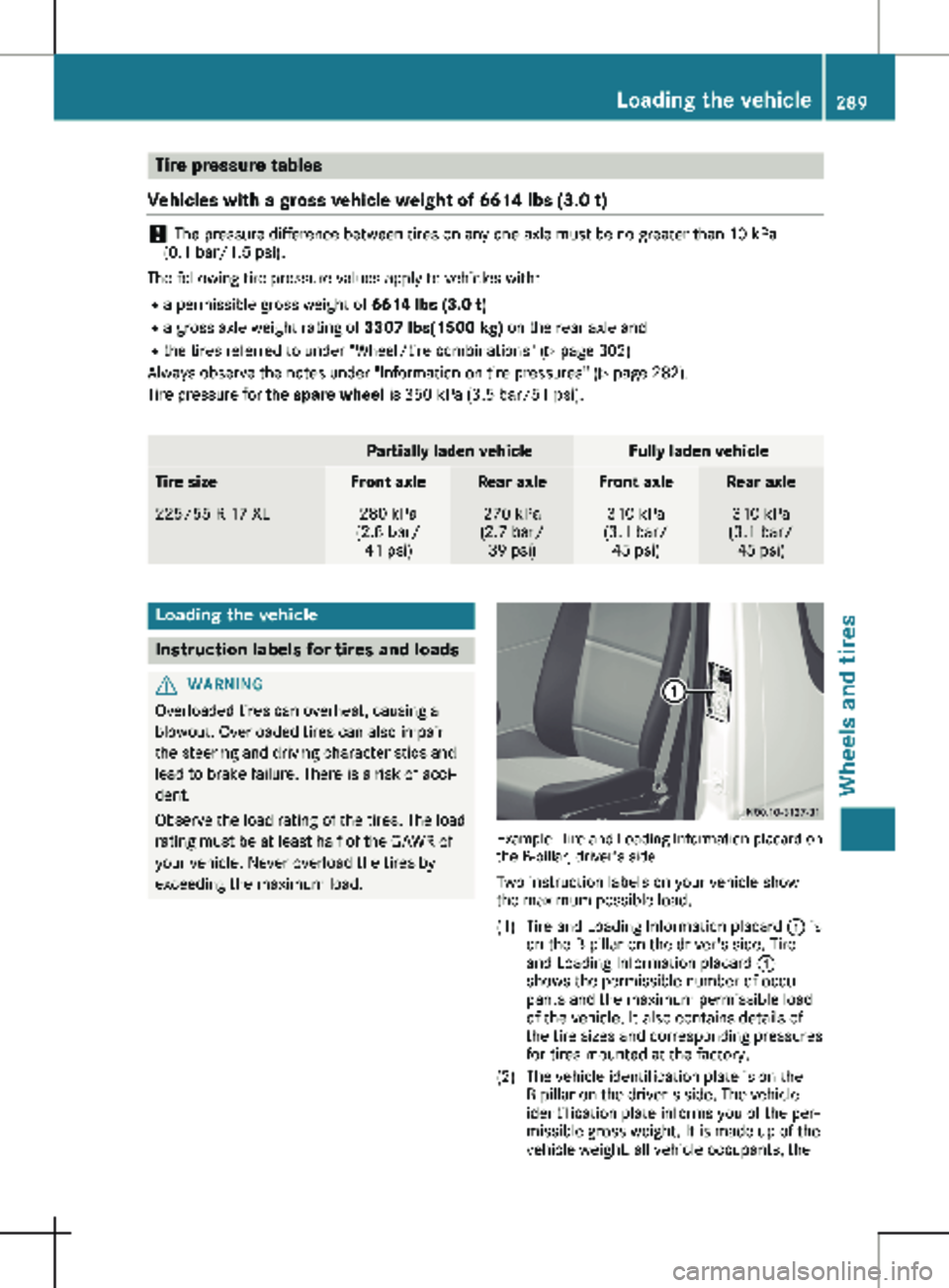
Tire pressure tables
Vehicles with a gross vehicle weight of 6614 lbs (3.0 t)!
The pressure difference between tires on any one axle must be no greater than
10 kPa
(0.1 bar/1.5 psi).
The following tire pressure values apply to vehicles with: R a permissible gross weight of 6614 lbs (3.0 t)
R a gross axle weight rating of 3307 lbs(1500 kg) on the rear axle and
R the tires referred to under "Wheel/tire combinations" (Y page 302)
Always observe the notes under "Information on tire pressures" (Y page 282).
Tire pressure for the spare wheel is 350 kPa (3.5 bar/51 psi).
Partially laden vehicle Fully laden vehicle
Tire size Front axle Rear axle Front axle Rear axle
225/55 R 17 XL 280 kPa
(2.8 bar/ 41 psi) 270 kPa
(2.7 bar/ 39 psi) 310 kPa
(3.1 bar/ 45 psi) 310 kPa
(3.1 bar/ 45 psi) Loading the vehicle
Instruction labels for tires and loads
G
WARNING
Overloaded tires can overheat, causing a
blowout. Overloaded tires can also impair
the steering and driving characteristics and
lead to brake failure. There is a risk of acci-
dent.
Observe the load rating of the tires. The load
rating must be at least half of the GAWR of
your vehicle. Never overload the tires by
exceeding the maximum load. Example: Tire and Loading Information placard on
the B-pillar, driver's side
Two instruction labels on your vehicle show
the maximum possible load.
(1) Tire and Loading Information placard : is
on the
B-pillar on the driver's side. Tire
and Loading Information placard :
shows the permissible number of occu-
pants and the maximum permissible load
of the vehicle. It also contains details of
the tire sizes and corresponding pressures
for tires mounted at the factory.
(2) The vehicle identification plate is on the B-pillar on the driver's side. The vehicle
identification plate informs you of the per-
missible gross weight. It is made up of the
vehicle weight, all vehicle occupants, the Loading the vehicle
289
Wheels and tires Z
Page 292 of 320
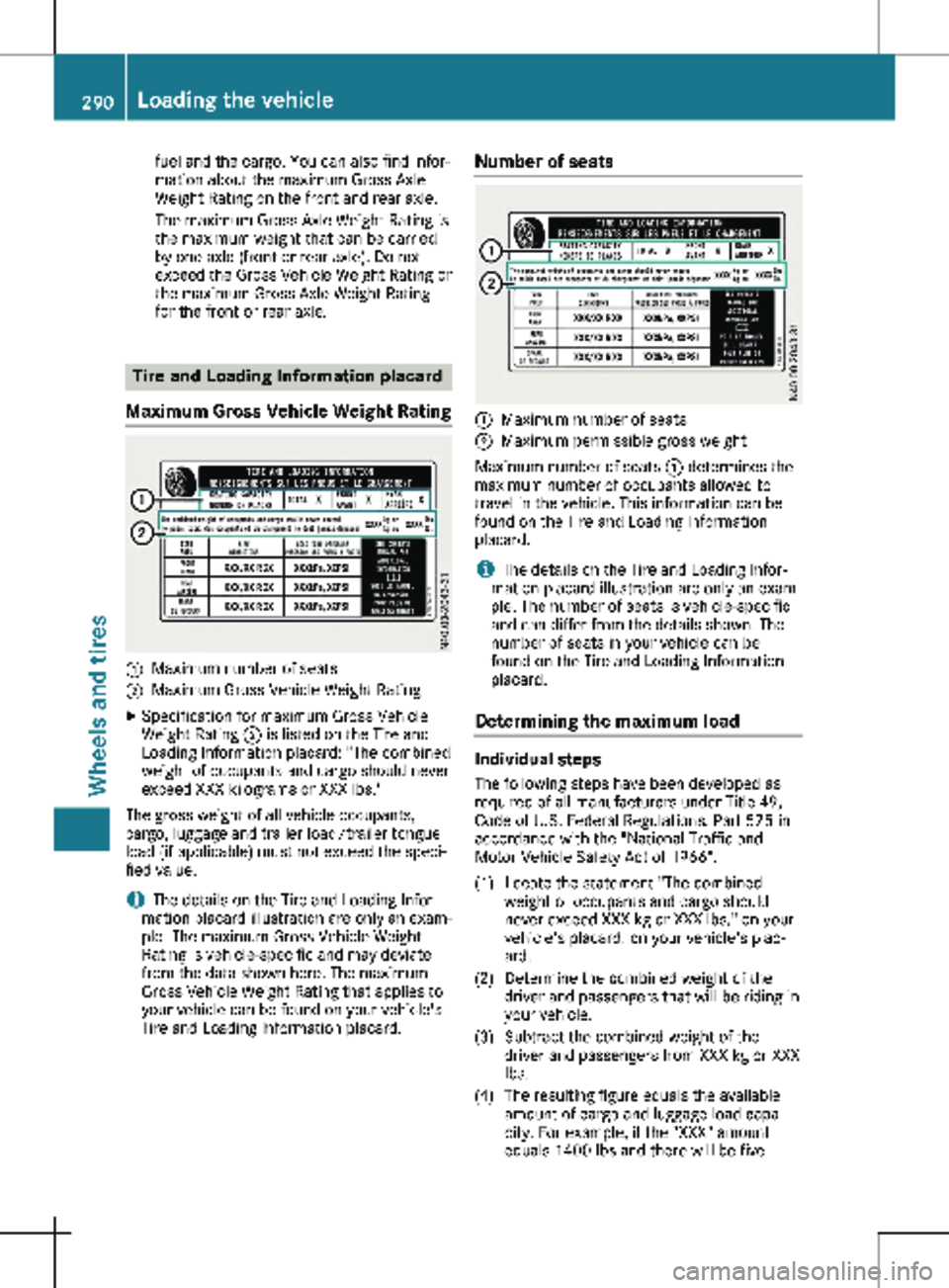
fuel and the cargo. You can also find infor-
mation about the maximum Gross Axle
Weight Rating on the front and rear axle.
The maximum Gross Axle Weight Rating is
the maximum weight that can be carried
by one axle (front or rear axle). Do not
exceed the Gross Vehicle Weight Rating or
the maximum Gross Axle Weight Rating
for the front or rear axle. Tire and Loading Information placard
Maximum Gross Vehicle Weight Rating :
Maximum number of seats
; Maximum Gross Vehicle Weight Rating
X Specification for maximum Gross Vehicle
Weight Rating ; is listed on the Tire and
Loading Information placard: "The combined
weight of occupants and cargo should never
exceed XXX kilograms or XXX lbs."
The gross weight of all vehicle occupants,
cargo, luggage and trailer load/trailer tongue
load (if applicable) must not exceed the speci-
fied value.
i The details on the Tire and Loading Infor-
mation placard illustration are only an exam-
ple. The maximum Gross Vehicle Weight
Rating is vehicle-specific and may deviate
from the data shown here. The maximum
Gross Vehicle Weight Rating that applies to
your vehicle can be found on your vehicle's
Tire and Loading Information placard. Number of seats
:
Maximum number of seats
; Maximum permissible gross weight
Maximum number of seats : determines the
maximum number of occupants allowed to
travel in the vehicle. This information can be
found on the Tire and Loading Information
placard.
i The details on the Tire and Loading Infor-
mation placard illustration are only an exam-
ple. The number of seats is vehicle-specific
and can differ from the details shown. The
number of seats in your vehicle can be
found on the Tire and Loading Information
placard.
Determining the maximum load Individual steps
The following steps have been developed as
required of all manufacturers under Title 49,
Code of U.S. Federal Regulations, Part 575 in
accordance with the "National Traffic and
Motor Vehicle Safety Act of 1966".
(1) Locate the statement "The combined weight of occupants and cargo should
never exceed XXX kg or XXX lbs." on your
vehicle's placard. on your vehicle's plac-
ard.
(2) Determine the combined weight of the driver and passengers that will be riding in
your vehicle.
(3) Subtract the combined weight of the driver and passengers from XXX kg or XXX
lbs.
(4) The resulting figure equals the available amount of cargo and luggage load capa-
city. For example, if the "XXX" amount
equals
1400 lbs and there will be five290
Loading the vehicle
Wheels and tires
Page 293 of 320
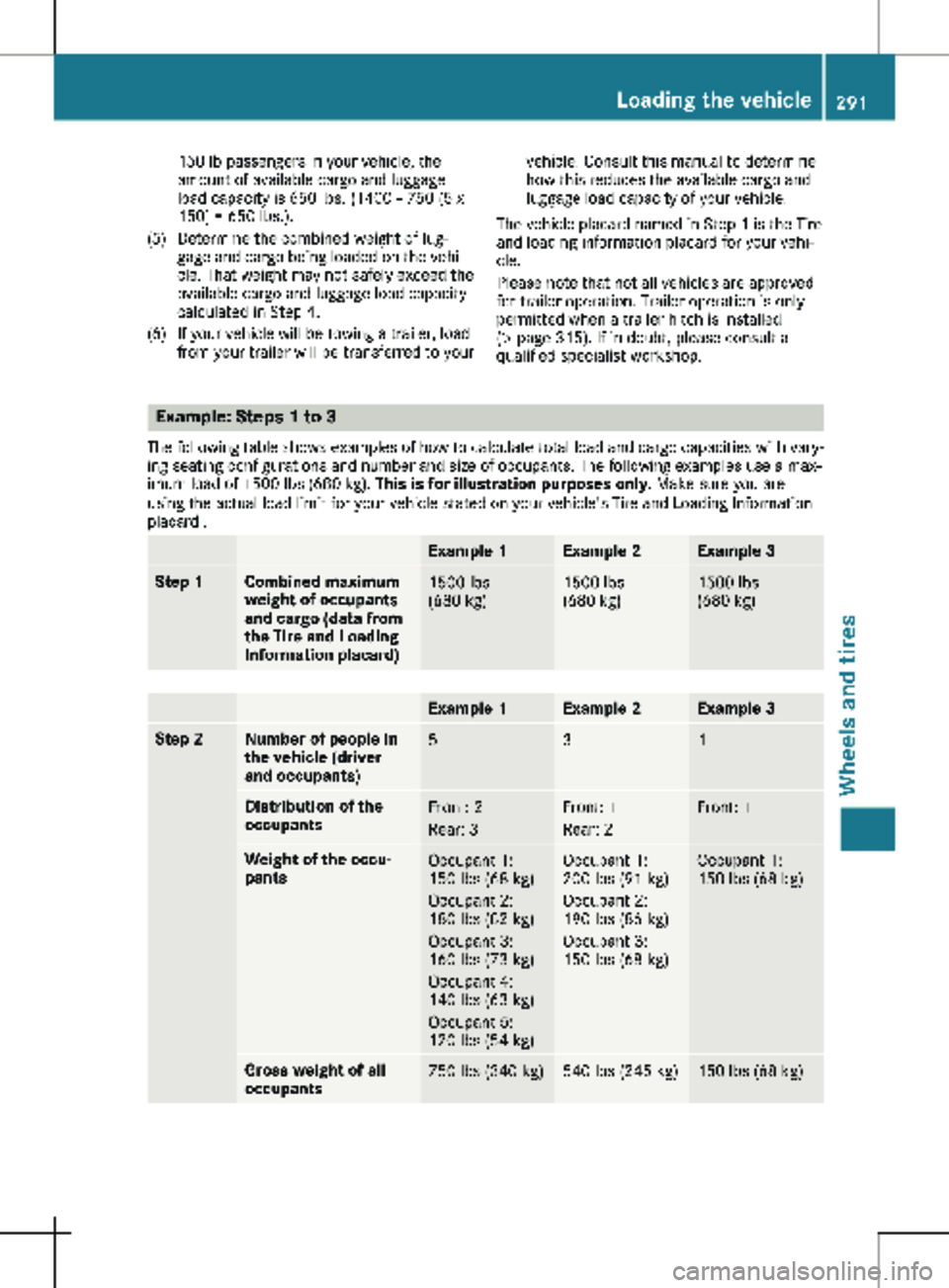
150 lb passengers in your vehicle, the
amount of available cargo and luggage
load capacity is
650 lbs. (1400 Ò 750 (5 x
150) = 650 lbs.).
(5) Determine the combined weight of lug- gage and cargo being loaded on the vehi-
cle. That weight may not safely exceed the
available cargo and luggage load capacity
calculated in Step 4.
(6) If your vehicle will be towing a trailer, load from your trailer will be transferred to your vehicle. Consult this manual to determine
how this reduces the available cargo and
luggage load capacity of your vehicle.
The vehicle placard named in Step 1 is the Tire
and loading information placard for your vehi-
cle.
Please note that not all vehicles are approved
for trailer operation. Trailer operation is only
permitted when a trailer hitch is installed
(Y page
315). If in doubt, please consult a
qualified specialist workshop. Example: Steps 1 to 3
The following table shows examples of how to calculate total load and cargo capacities with vary-
ing seating configurations and number and size of occupants. The following examples use a max-
imum load of
1500 lbs (680 kg). This is for illustration purposes only. Make sure you are
using the actual load limit for your vehicle stated on your vehicle's Tire and Loading Information
placard . Example 1 Example 2 Example 3
Step 1 Combined maximum
weight of occupants
and cargo (data from
the Tire and Loading
Information placard)
1500 lbs
(680 kg
) 1500 lbs
(680 kg
) 1500 lbs
(680 kg
) Example 1 Example 2 Example 3
Step 2 Number of people in
the vehicle (driver
and occupants)
5 3 1
Distribution of the
occupants
Front: 2
Rear: 3 Front: 1
Rear: 2 Front: 1
Weight of the occu-
pants
Occupant 1:
150 lbs (68 kg
)
Occupant 2:
180 lbs (82 kg)
Occupant 3:
160 lbs (73 kg)
Occupant 4:
140 lbs (63 kg)
Occupant 5:
120 lbs (54 kg) Occupant 1:
200 lbs (91 kg
)
Occupant 2:
190 lbs (86 kg)
Occupant 3:
150 lbs (68 kg) Occupant 1:
150 lbs (68 kg
) Gross weight of all
occupants
750 lbs (340 kg) 540 lbs (245 kg) 150 lbs (68 kg)Loading the vehicle
291
Wheels and tires Z
Page 294 of 320
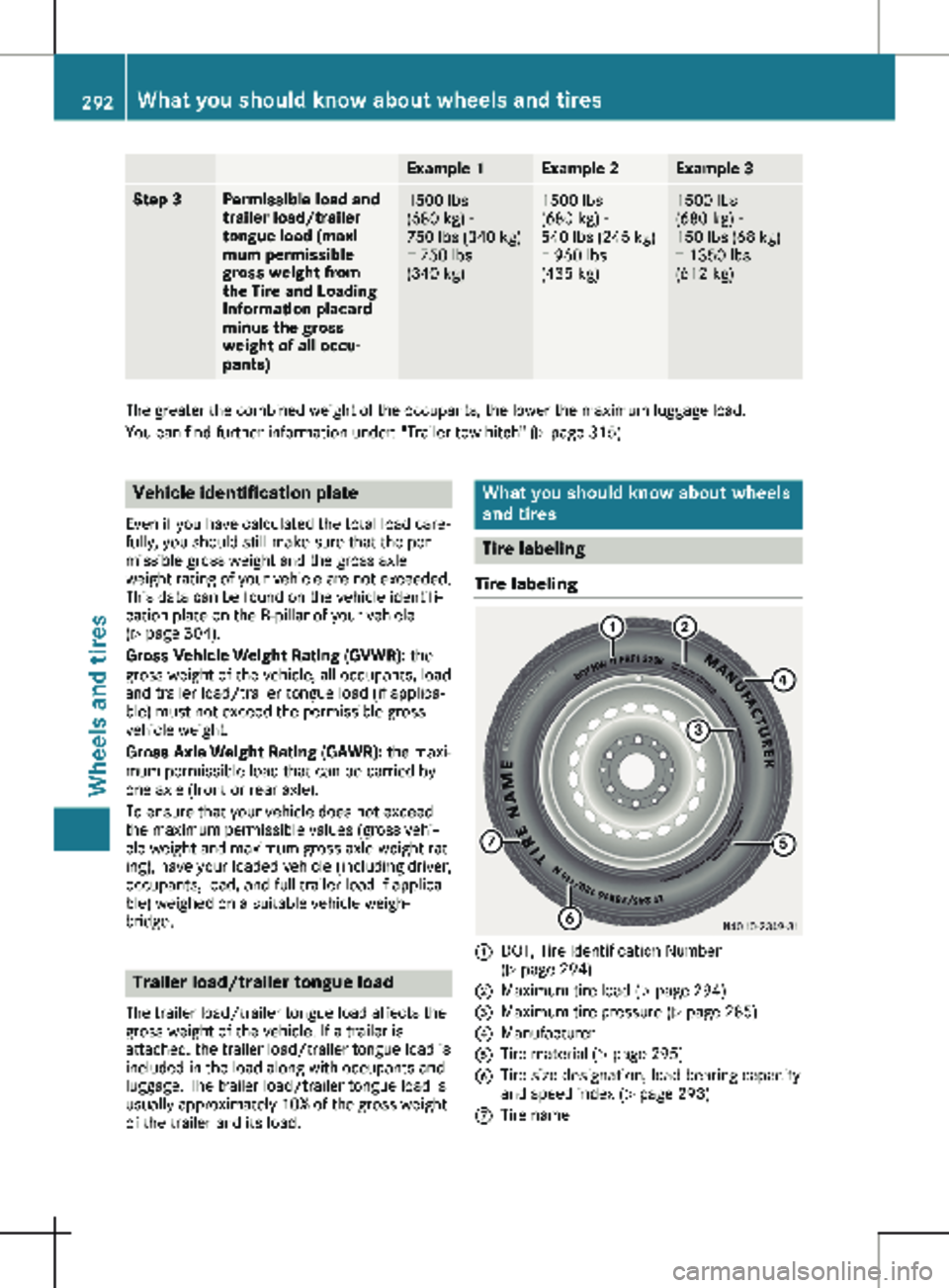
Example 1 Example 2 Example 3
Step 3 Permissible load and
trailer load/trailer
tongue load (maxi-
mum permissible
gross weight from
the Tire and Loading
Information placard
minus the gross
weight of all occu-
pants)
1500 lbs
(680 kg
) Ò
750 lbs (340 kg)
= 750 lbs
(340 kg) 1500 lbs
(680 kg
) Ò
540 lbs (245 kg)
= 960 lbs
(435 kg) 1500 lbs
(680 kg
) Ò
150 lbs (68 kg)
= 1350 lbs
(612 kg) The greater the combined weight of the occupants, the lower the maximum luggage load.
You can find further information under: "Trailer tow hitch"
(Y page 315).Vehicle identification plate
Even if you have calculated the total load care-
fully, you should still make sure that the per-
missible gross weight and the gross axle
weight rating of your vehicle are not exceeded.
This data can be found on the vehicle identifi-
cation plate on the B-pillar of your vehicle
(Y page
304).
Gross Vehicle Weight Rating (GVWR): the
gross weight of the vehicle, all occupants, load
and trailer load/trailer tongue load (if applica-
ble) must not exceed the permissible gross
vehicle weight.
Gross Axle Weight Rating (GAWR): the maxi-
mum permissible load that can be carried by
one axle (front or rear axle).
To ensure that your vehicle does not exceed
the maximum permissible values (gross vehi-
cle weight and maximum gross axle weight rat-
ing), have your loaded vehicle (including driver,
occupants, load, and full trailer load if applica-
ble) weighed on a suitable vehicle weigh-
bridge. Trailer load/trailer tongue load
The trailer load/trailer tongue load affects the
gross weight of the vehicle. If a trailer is
attached, the trailer load/trailer tongue load is
included in the load along with occupants and
luggage. The trailer load/trailer tongue load is
usually approximately
10% of the gross weight
of the trailer and its load. What you should know about wheels
and tires
Tire labeling
Tire labeling :
DOT, Tire Identification Number
(Y page
294)
; Maximum tire load (Y page
294)
= Maximum tire pressure ( Y page
285)
? Manufacturer
A Tire material ( Y page
295)
B Tire size designation, load-bearing capacity
and speed index
(Y page 293)
C Tire name292
What you should know about wheels and tires
Wheels and tires
Page 295 of 320
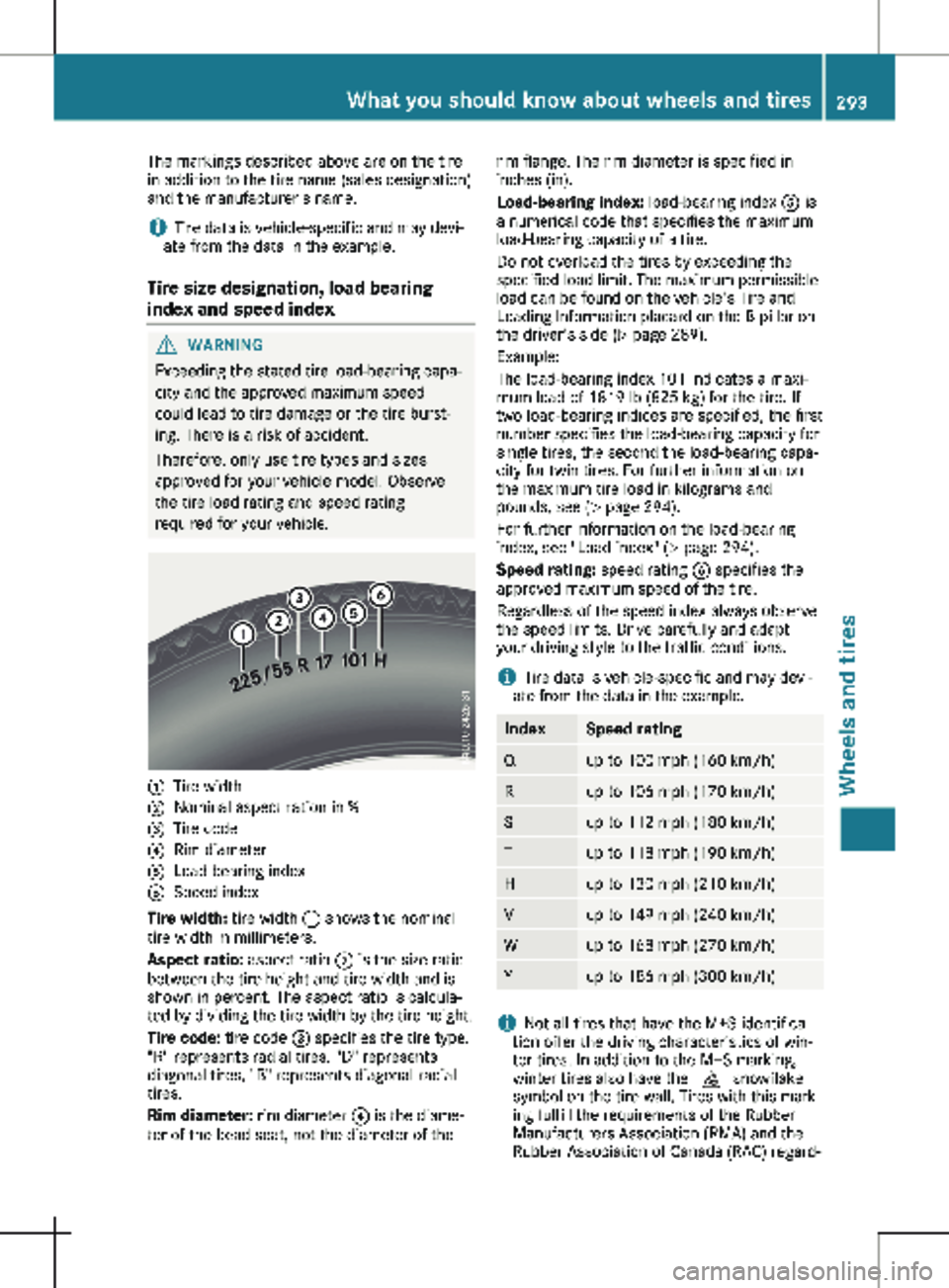
The markings described above are on the tire
in addition to the tire name (sales designation)
and the manufacturer's name.
i Tire data is vehicle-specific and may devi-
ate from the data in the example.
Tire size designation, load bearing
index and speed index G
WARNING
Exceeding the stated tire load-bearing capa-
city and the approved maximum speed
could lead to tire damage or the tire burst-
ing. There is a risk of accident.
Therefore, only use tire types and sizes
approved for your vehicle model. Observe
the tire load rating and speed rating
required for your vehicle. :
Tire width
; Nominal aspect ration in %
= Tire code
? Rim diameter
A Load bearing index
B Speed index
Tire width: tire width : shows the nominal
tire width in millimeters.
Aspect ratio: aspect ratio ; is the size ratio
between the tire height and tire width and is
shown in percent. The aspect ratio is calcula-
ted by dividing the tire width by the tire height.
Tire code: tire code = specifies the tire type.
"R" represents radial tires. "D" represents
diagonal tires, "B" represents diagonal radial
tires.
Rim diameter: rim diameter ? is the diame-
ter of the bead seat, not the diameter of the rim flange. The rim diameter is specified in
inches (in).
Load-bearing index: load-bearing index
A is
a numerical code that specifies the maximum
load-bearing capacity of a tire.
Do not overload the tires by exceeding the
specified load limit. The maximum permissible
load can be found on the vehicle's Tire and
Loading Information placard on the B-pillar
on
the driver's side (Y page 289).
Example:
The load-bearing index 101 indicates a maxi-
mum load of 1819 lb (825 kg) for the tire. If
two load-bearing indices are specified, the first
number specifies the load-bearing capacity for
single tires, the second the load-bearing capa-
city for twin tires. For further information on
the maximum tire load in kilograms and
pounds, see (Y page 294). For further information on the load-bearing
index, see "Load index" (Y page 294).
Speed rating: speed rating B specifies the
approved maximum speed of the tire.
Regardless of the speed index always observe
the speed limits. Drive carefully and adapt
your driving style to the traffic conditions.
i Tire data is vehicle-specific and may devi-
ate from the data in the example. Index Speed rating
Q up to 100 mph (160 km/h)
R up to 106 mph (170 km/h)
S up to 112 mph (180 km/h)
T up to 118 mph (190 km/h)
H up to 130 mph (210 km/h)
V up to 149 mph (240 km/h)
W up to 168 mph (270 km/h)
Y up to 186 mph (300 km/h)
i
Not all tires that have the
M+S identifica-
tion offer the driving characteristics of win-
ter tires. In addition to the M+S marking,
winter tires also have the i snowflake
symbol on the tire wall. Tires with this mark-
ing fulfill the requirements of the Rubber
Manufacturers Association (RMA) and the
Rubber Association of Canada (RAC) regard- What you should know about wheels and tires
293
Wheels and tires Z
Page 296 of 320

ing the tire traction on snow. They have
been especially developed for driving on
snow.
Further information on the reading of tire infor-
mation can be obtained at any qualified spe-
cialist workshop.
Load index Load index (example)
In addition to the load-bearing index, load rat-
ing : may be imprinted after the letters that
identify speed rating on the sidewall of the tire
(Y page
293).
R If no specification is given: no text (as in the
example above), represents a standard load
(SL) tire
R RF or Reinforced: represents a reinforced
tire. Alternatively, depending on the manu-
facturer, the designation XL (Extra Load) can
be used.
R Light Load: represents a light load tire
R C, D, E: represents a load range that
depends on the maximum load that the tire
can carry at a certain pressure
i Tire data is vehicle-specific and may devi-
ate from the data in the example. Maximum tire load Example: maximum tire load
Maximum tire load : is the maximum permis-
sible weight for which the tire is approved.
Do not overload the tires by exceeding the
specified load limit. The maximum permissible
load can be found on the vehicle's Tire and
Loading Information placard on the B-pillar
on
the driver's side (Y page 289).
i The actual values for tires are specific to
each vehicle and may deviate from the val-
ues in the illustration.
DOT, Tire Identification Number (TIN) U.S. tire regulations stipulate that every tire
manufacturer or retreader must imprint a TIN
in or on the sidewall of each tire produced. The TIN is a unique identification number. The
TIN enables the tire manufacturers or retread-
ers to inform purchasers of recalls and other
safety-relevant matters. It makes it possible
for the purchaser to easily identify the affected
tires.
The TIN is made up of manufacturer identifica-
tion code ;, tire size =, tire type code ?
and manufacturing date A. 294
What you should know about wheels and tires
Wheels and tires
Page 297 of 320
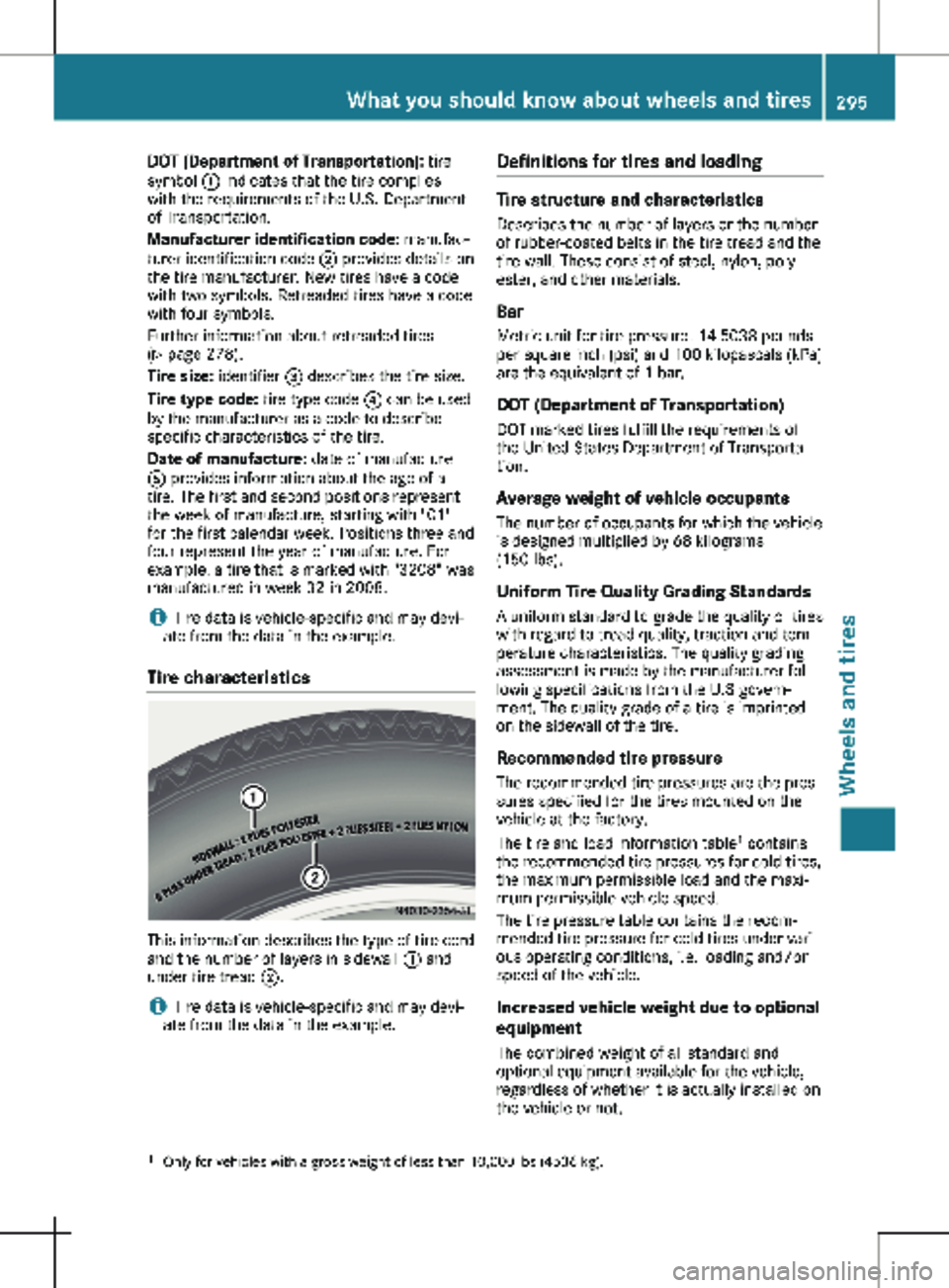
DOT (Department of Transportation):
tire
symbol : indicates that the tire complies
with the requirements of the U.S. Department
of Transportation.
Manufacturer identification code: manufac-
turer identification code ; provides details on
the tire manufacturer. New tires have a code
with two symbols. Retreaded tires have a code
with four symbols.
Further information about retreaded tires
(Y page
278).
Tire size: identifier = describes the tire size.
Tire type code: tire type code ? can be used
by the manufacturer as a code to describe
specific characteristics of the tire.
Date of manufacture: date of manufacture
A provides information about the age of a
tire. The first and second positions represent
the week of manufacture, starting with "01"
for the first calendar week. Positions three and
four represent the year of manufacture. For
example, a tire that is marked with "3208" was
manufactured in week 32 in 2008.
i Tire data is vehicle-specific and may devi-
ate from the data in the example.
Tire characteristics This information describes the type of tire cord
and the number of layers in sidewall : and
under tire tread ;.
i Tire data is vehicle-specific and may devi-
ate from the data in the example. Definitions for tires and loading Tire structure and characteristics
Describes the number of layers or the number
of rubber-coated belts in the tire tread and the
tire wall. These consist of steel, nylon, poly-
ester, and other materials.
Bar
Metric unit for tire pressure.
14.5038 pounds
per square inch (psi) and 100 kilopascals (kPa)
are the equivalent of 1 bar.
DOT (Department of Transportation)
DOT marked tires fulfill the requirements of
the United States Department of Transporta-
tion.
Average weight of vehicle occupantsThe number of occupants for which the vehicle
is designed multiplied by 68 kilograms
(150 lbs).
Uniform Tire Quality Grading Standards A uniform standard to grade the quality of tires
with regard to tread quality, traction and tem-
perature characteristics. The quality grading
assessment is made by the manufacturer fol-
lowing specifications from the U.S govern-
ment. The quality grade of a tire is imprinted
on the sidewall of the tire.
Recommended tire pressure
The recommended tire pressures are the pres-
sures specified for the tires mounted on the
vehicle at the factory.
The tire and load information table 1
contains
the recommended tire pressures for cold tires,
the maximum permissible load and the maxi-
mum permissible vehicle speed.
The tire pressure table contains the recom-
mended tire pressure for cold tires under vari-
ous operating conditions, i.e. loading and/or
speed of the vehicle.
Increased vehicle weight due to optional
equipment
The combined weight of all standard and
optional equipment available for the vehicle,
regardless of whether it is actually installed on
the vehicle or not.
1 Only for vehicles with a gross weight of less than
10,000 lbs (4536 kg).What you should know about wheels and tires
295
Wheels and tires Z
Page 298 of 320
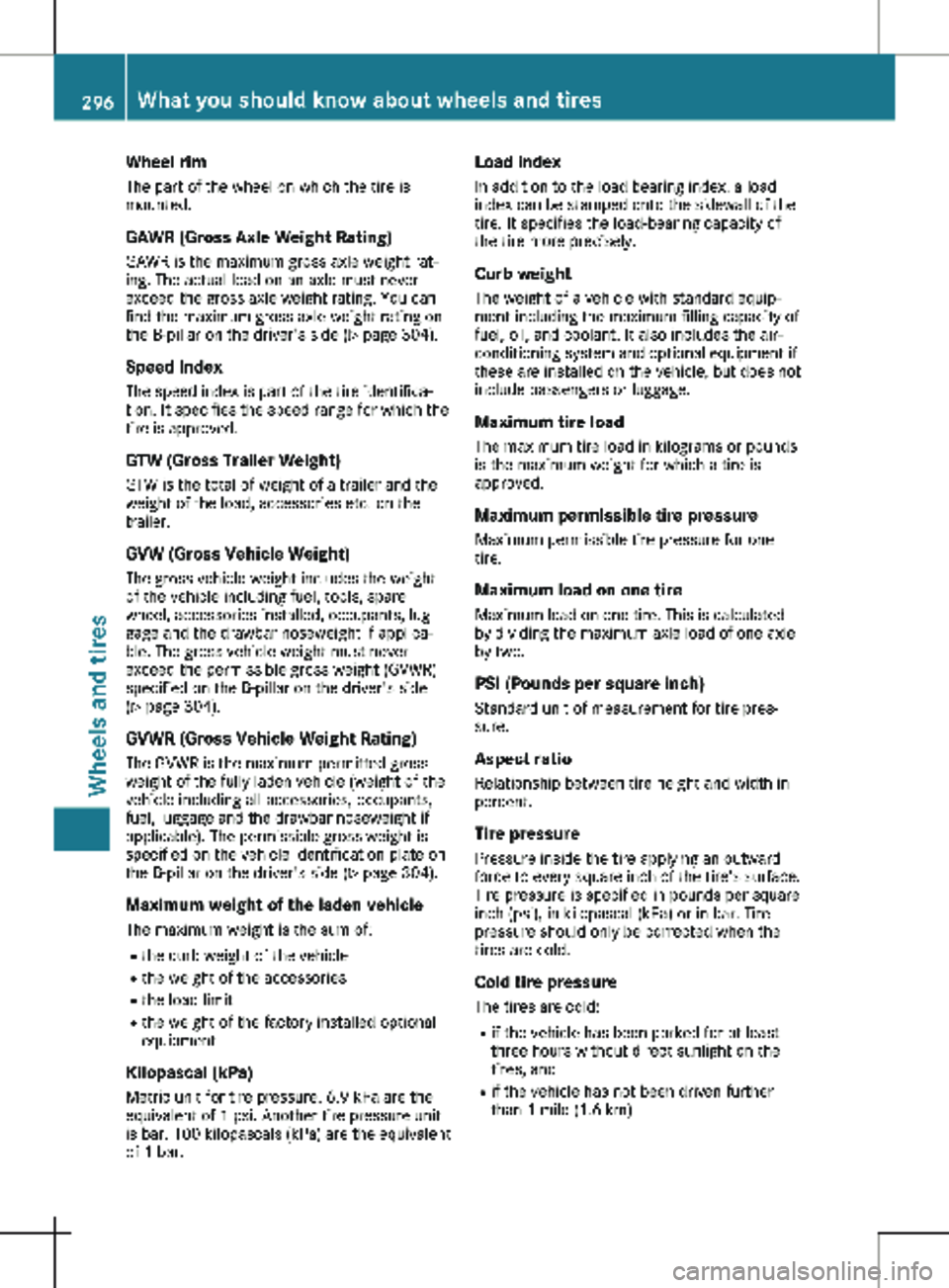
Wheel rim
The part of the wheel on which the tire is
mounted.
GAWR (Gross Axle Weight Rating) GAWR is the maximum gross axle weight rat-
ing. The actual load on an axle must never
exceed the gross axle weight rating. You can
find the maximum gross axle weight rating on
the
B-pillar on the driver's side ( Y page 304).
Speed index The speed index is part of the tire identifica-
tion. It specifies the speed range for which the
tire is approved.
GTW (Gross Trailer Weight) GTW is the total of weight of a trailer and the
weight of the load, accessories etc. on the
trailer.
GVW (Gross Vehicle Weight)
The gross vehicle weight includes the weight
of the vehicle including fuel, tools, spare
wheel, accessories installed, occupants, lug-
gage and the drawbar noseweight if applica-
ble. The gross vehicle weight must never
exceed the permissible gross weight (GVWR)
specified on the B-pillar on the driver's side
(Y page 304).
GVWR (Gross Vehicle Weight Rating) The GVWR is the maximum permitted gross
weight of the fully laden vehicle (weight of the
vehicle including all accessories, occupants,
fuel, luggage and the drawbar noseweight if
applicable). The permissible gross weight is
specified on the vehicle identification plate on
the B-pillar on the driver's side (Y page 304).
Maximum weight of the laden vehicle
The maximum weight is the sum of:
R the curb weight of the vehicle
R the weight of the accessories
R the load limit
R the weight of the factory installed optional
equipment
Kilopascal (kPa) Metric unit for tire pressure. 6.9 kPa are the
equivalent of 1 psi. Another tire pressure unit
is bar. 100 kilopascals (kPa) are the equivalent
of 1 bar. Load index
In addition to the load bearing index, a load
index can be stamped onto the sidewall of the
tire. It specifies the load-bearing capacity of
the tire more precisely.
Curb weight The weight of a vehicle with standard equip-
ment including the maximum filling capacity of
fuel, oil, and coolant. It also includes the air-
conditioning system and optional equipment if
these are installed on the vehicle, but does not
include passengers or luggage.
Maximum tire load
The maximum tire load in kilograms or pounds
is the maximum weight for which a tire is
approved.
Maximum permissible tire pressure
Maximum permissible tire pressure for one
tire.
Maximum load on one tire
Maximum load on one tire. This is calculated
by dividing the maximum axle load of one axle
by two.
PSI (Pounds per square inch)
Standard unit of measurement for tire pres-
sure.
Aspect ratioRelationship between tire height and width in
percent.
Tire pressure
Pressure inside the tire applying an outward
force to every square inch of the tire's surface.
Tire pressure is specified in pounds per square
inch (psi), in kilopascal (kPa) or in bar. Tire
pressure should only be corrected when the
tires are cold.
Cold tire pressure The tires are cold:
R if the vehicle has been parked for at least
three hours without direct sunlight on the
tires, and
R if the vehicle has not been driven further
than
1 mile (1.6 km)296
What you should know about wheels and tires
Wheels and tires
Page 299 of 320
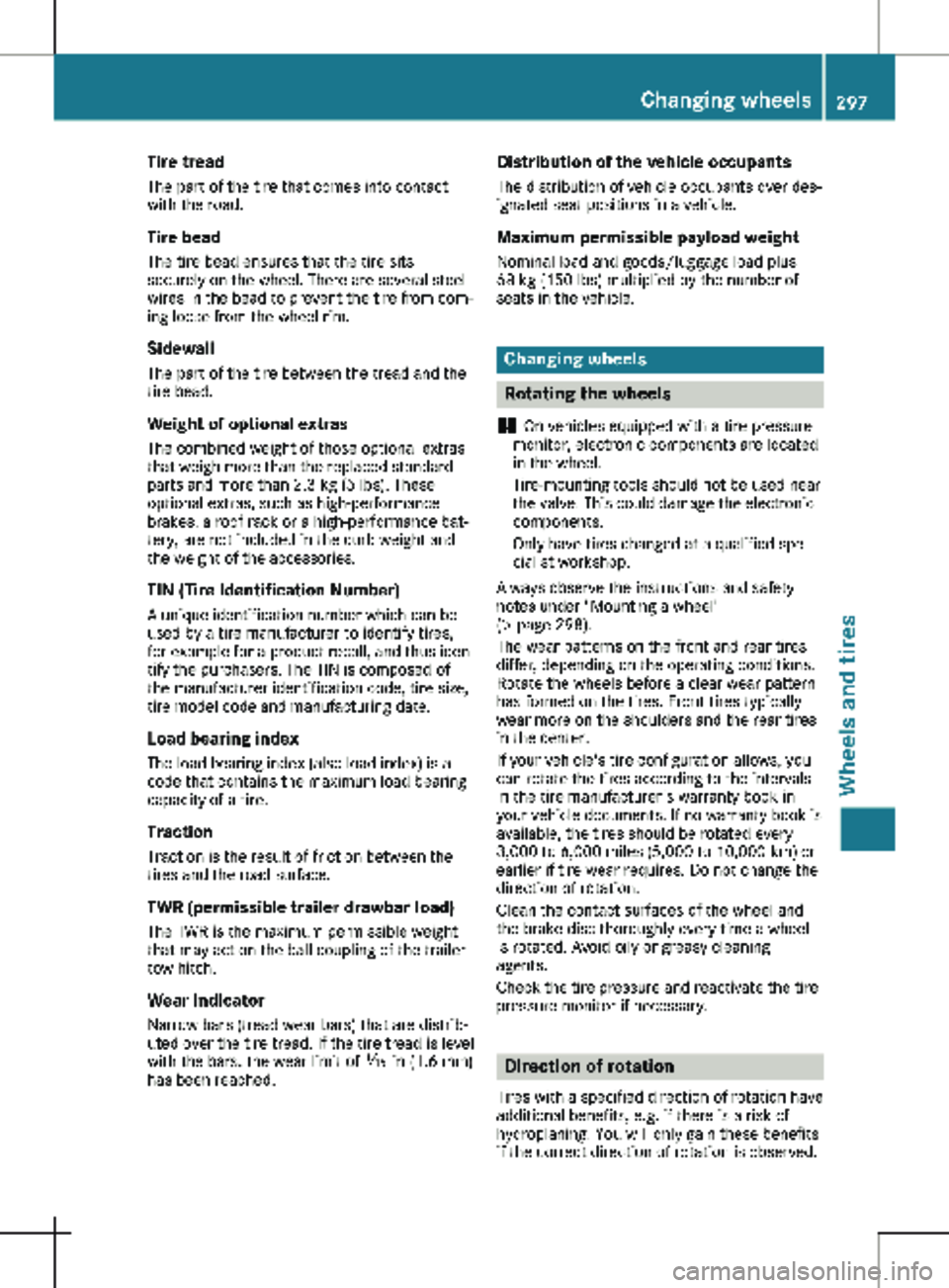
Tire tread
The part of the tire that comes into contact
with the road.
Tire bead
The tire bead ensures that the tire sits
securely on the wheel. There are several steel
wires in the bead to prevent the tire from com-
ing loose from the wheel rim.
SidewallThe part of the tire between the tread and the
tire bead.
Weight of optional extras The combined weight of those optional extras
that weigh more than the replaced standard
parts and more than 2.3 kg
(5 lbs). These
optional extras, such as high-performance
brakes, a roof rack or a high-performance bat-
tery, are not included in the curb weight and
the weight of the accessories.
TIN (Tire Identification Number) A unique identification number which can be
used by a tire manufacturer to identify tires,
for example for a product recall, and thus iden-
tify the purchasers. The TIN is composed of
the manufacturer identification code, tire size,
tire model code and manufacturing date.
Load bearing index
The load bearing index (also load index) is a
code that contains the maximum load bearing
capacity of a tire.
Traction
Traction is the result of friction between the
tires and the road surface.
TWR (permissible trailer drawbar load)
The TWR is the maximum permissible weight
that may act on the ball coupling of the trailer
tow hitch.
Wear indicator Narrow bars (tread wear bars) that are distrib-
uted over the tire tread. If the tire tread is level
with the bars, the wear limit of á in (1.6 mm)
has been reached. Distribution of the vehicle occupants
The distribution of vehicle occupants over des-
ignated seat positions in a vehicle.
Maximum permissible payload weightNominal load and goods/luggage load plus
68 kg (150 lbs) multiplied by the number of
seats in the vehicle. Changing wheels
Rotating the wheels
! On vehicles equipped with a tire pressure
monitor, electronic components are located
in the wheel.
Tire-mounting tools should not be used near
the valve. This could damage the electronic
components.
Only have tires changed at a qualified spe-
cialist workshop.
Always observe the instructions and safety
notes under "Mounting a wheel"
(Y page
298).
The wear patterns on the front and rear tires
differ, depending on the operating conditions.
Rotate the wheels before a clear wear pattern
has formed on the tires. Front tires typically
wear more on the shoulders and the rear tires
in the center.
If your vehicle's tire configuration allows, you
can rotate the tires according to the intervals
in the tire manufacturer's warranty book in
your vehicle documents. If no warranty book is
available, the tires should be rotated every
3,000 to 6,000 miles (5,000 to 10,000 km) or
earlier if tire wear requires. Do not change the
direction of rotation.
Clean the contact surfaces of the wheel and
the brake disc thoroughly every time a wheel
is rotated. Avoid oily or greasy cleaning
agents.
Check the tire pressure and reactivate the tire
pressure monitor if necessary. Direction of rotation
Tires with a specified direction of rotation have
additional benefits, e.g. if there is a risk of
hydroplaning. You will only gain these benefits
if the correct direction of rotation is observed. Changing wheels
297
Wheels and tires Z
Page 300 of 320
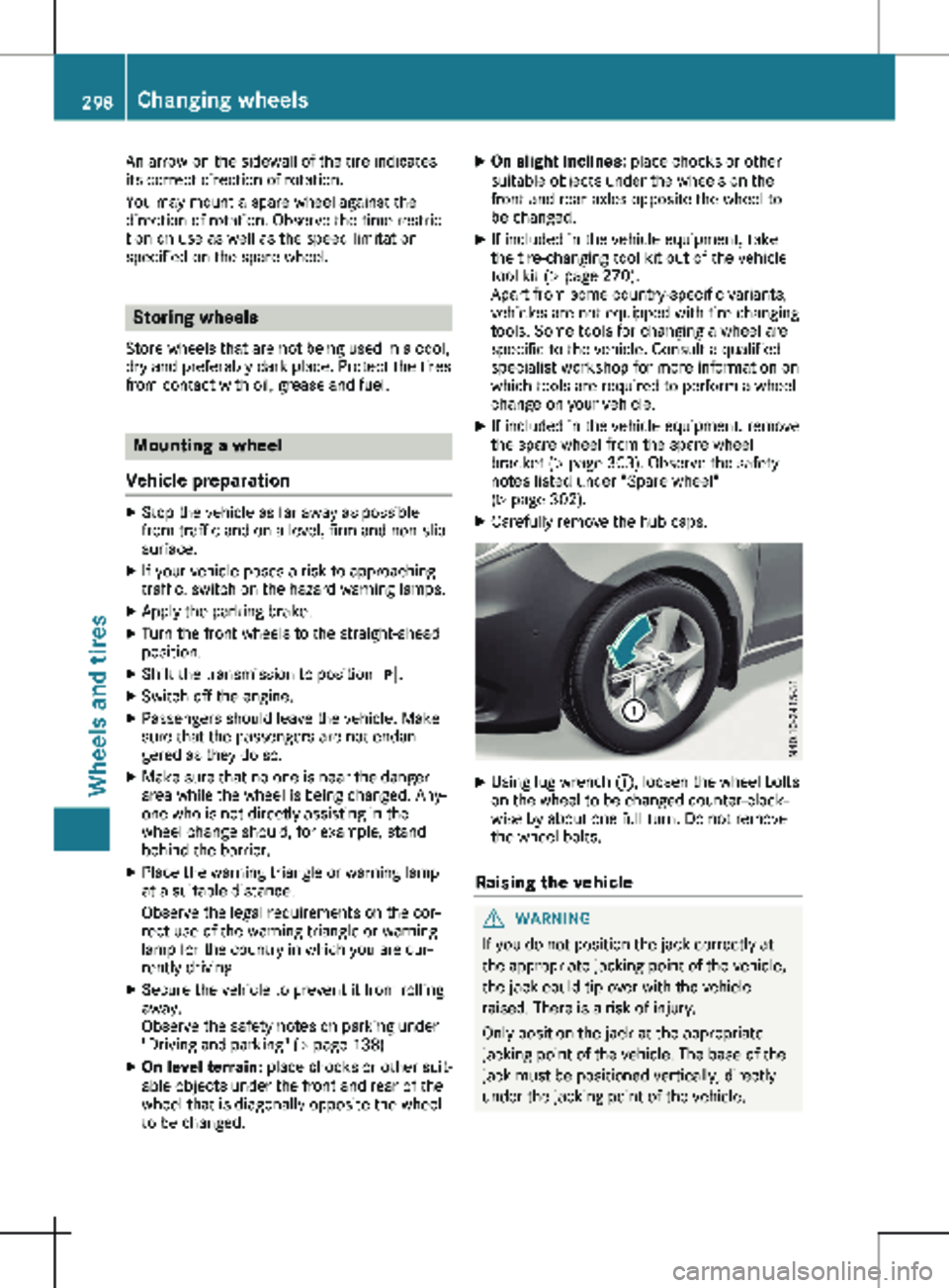
An arrow on the sidewall of the tire indicates
its correct direction of rotation.
You may mount a spare wheel against the
direction of rotation. Observe the time restric-
tion on use as well as the speed limitation
specified on the spare wheel. Storing wheels
Store wheels that are not being used in a cool,
dry and preferably dark place. Protect the tires
from contact with oil, grease and fuel. Mounting a wheel
Vehicle preparation X
Stop the vehicle as far away as possible
from traffic and on a level, firm and non-slip
surface.
X If your vehicle poses a risk to approaching
traffic, switch on the hazard warning lamps.
X Apply the parking brake.
X Turn the front wheels to the straight-ahead
position.
X Shift the transmission to position j.
X Switch off the engine.
X Passengers should leave the vehicle. Make
sure that the passengers are not endan-
gered as they do so.
X Make sure that no one is near the danger
area while the wheel is being changed. Any-
one who is not directly assisting in the
wheel change should, for example, stand
behind the barrier.
X Place the warning triangle or warning lamp
at a suitable distance.
Observe the legal requirements on the cor-
rect use of the warning triangle or warning
lamp for the country in which you are cur-
rently driving
X Secure the vehicle to prevent it from rolling
away.
Observe the safety notes on parking under
"Driving and parking"
(Y page 138)
X On level terrain: place chocks or other suit-
able objects under the front and rear of the
wheel that is diagonally opposite the wheel
to be changed. X
On slight inclines: place chocks or other
suitable objects under the wheels on the
front and rear axles opposite the wheel to
be changed.
X If included in the vehicle equipment, take
the tire-changing tool kit out of the vehicle
tool kit (Y page
270).
Apart from some country-specific variants,
vehicles are not equipped with tire-changing
tools. Some tools for changing a wheel are
specific to the vehicle. Consult a qualified
specialist workshop for more information on
which tools are required to perform a wheel
change on your vehicle.
X If included in the vehicle equipment, remove
the spare wheel from the spare wheel
bracket
(Y page 303). Observe the safety
notes listed under "Spare wheel"
(Y page 302).
X Carefully remove the hub caps. X
Using lug wrench :, loosen the wheel bolts
on the wheel to be changed counter-clock-
wise by about one full turn. Do not remove
the wheel bolts.
Raising the vehicle G
WARNING
If you do not position the jack correctly at
the appropriate jacking point of the vehicle,
the jack could tip over with the vehicle
raised. There is a risk of injury.
Only position the jack at the appropriate
jacking point of the vehicle. The base of the
jack must be positioned vertically, directly
under the jacking point of the vehicle. 298
Changing wheels
Wheels and tires